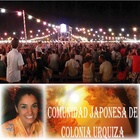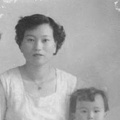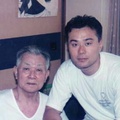The Tsuru family in Japan
This story is based on an interview with Mr. Tsuru, about his family in Japan and Argentina. He began by telling us that the surname Tsuru is more than a millennium old, but that the records date back to the time of the samurai (10th century), when the surname began to be used. But, it was only during the period of Emperor Meiji that the respective proclamation was raised that socially convulsed the empire. Until 1868, only the samurai caste had the right to a family name, in addition to their own, and they were grouped into clans. The reform - called Bakumatsu - took some time to be established and, at the insistence of public servants to carry out the registration, the residents gradually attended by giving the registry the surnames they had chosen. Some presented the surname of the feudal lord whom they served, others that of their village or city of origin and some were even creative by inventing and combining names of the parents or the place, although ultimately, and with the samurai caste abolished, those names left automatically having weight. According to Tsuru san, his surname is more than 2,000 years old and the meaning of the kanji is “abandoned port or delta.”
Mr. Tsuru was born in Korea (when it was annexed to Japan, but he is recognized as a Japanese citizen), on the northern border with the North Korean line 34 parallel. At that time it was called “Korea Kokaido Sainen Collican”. Mr. Tsuru says that his father Jiro was born and lived in a town called Mitsuhashi machi- Yamato gon, Fukuoka ken and that his mother Chiyo was from Yanagawa. They got married following the custom of being introduced by a “matchmaker.” Jiro went to Korea to work as a farmer, especially in the summer to harvest rice and in the winter he dedicated himself to hunting, until World War II began. Economically he was doing very well. He was saved from going to war, being 30 years old; but it suffered its consequences, because when Japan lost the war, all the countries that had been under the Empire, or like Korea annexed, were repatriated and the Japanese were thrown out by the Koreans and fled with what they had on. Some were taken to Siberia, but many returned to their villages in Japan to start over, as happened to the Tsuru family who first returned to Japan and, overcome by resignation, had to seek, over time, better luck, first in Paraguay and then in Argentina.
In Mitsuhashi (which was annexed to Yanagawa in 2007 1 ), Jiro's parents had rented the land they owned as sharecroppers and - due to a change in laws by the new government after the war, when the laborers and sharecroppers benefited because they were granted the lands - the Tsuru family lost their property, but Keizo had been a good employer and his neighbors recognized him as a great man. He asked his sharers if they could give him 10% of the land so he and his family could survive, and thus he recovered a good amount. Jiro began to work on one of the hectares, harvesting rice and prospering.
Mr. Tsuru was already in high school, which had a technical orientation in agronomy, when his father Jiro thought that he should improve the family situation and, with some money saved, go to South America, encouraged by a Brazilian farmers magazine that had reached his hands. He consulted with the Prefectural Government how he should go as an immigrant to the Dominican Republic, but at that moment he received news of the failure of the immigration colonies in that country. Then he thought about Bolivia, where they gave out free land; But, he decided on Paraguay, where he had to pay a fee and that way no one could claim anything from him, since it was not free (Uruguay and Argentina did not yet encourage immigration). He then decided on Paraguay, arriving in Colonia Fran, where he bought a land of 25 hectares and over time another land of another 25 hectares; but those lots were not very good because they were full of stones (currently no one lives in them). After 6 years he tried to look for a better place and his older brother Osamu called him to come to Argentina.
The transoceanic trip and the family in South America
Mr. Tsuru remembers the crossing of the transoceanic trip: “my father Jiro's entire family traveled on the Brasiru-Maru Ship from Kobe on December 28, 1957, arriving in Yokohama on December 31, spending the beginning of the New Year on the High Seas. Then they travel to Los Angeles, via the Panama Canal towards the Dominican Republic, where 10 families disembark and continue to Venezuela, Belén, Arrecife, Rio de Janeiro, Santos, Río Grande, Buenos Aires. In the latter, they went from the transoceanic ship to a steam ship that left from Retiro to Concepción del Uruguay, where they waited for the train that came from Chacarita to Posadas, then Encarnación and La Paz, the current colony of Japanese in Paraguay, the trip that lasted a month. and a half".
Continuing the thread of family history, he comments that Osamu, his older brother, met his wife Fmie in Paraguay, he worked as an employee of the farmers' cooperative and had knowledge because he had studied commerce in Japan. Fmie's sister had married a flower grower from Buenos Aires named Tnka, through a “matchmaker.” Mr. Tsuru marries NT and they arrive in Chivilcoy and then move to Colonia Urquiza in La Plata (final destination in Argentina). The first to arrive in Argentina was Osamu, then Tkeo (he had studied at the Encarnación school and, once he finished his studies, the possibility arose of moving to Buenos Aires and the third Jiro with Chiyo and finally Mr. Tsuru. Tkeo (younger brother) and Tsuru san helped move the Osamu greenhouses from Chivilcoy to Colonia Urquiza. Mr. Tsuru lived for a time on the Osamu land, then he rented the adjacent land and only in 1971 was he able to buy a 4 hectare plot of land. , where you live now.
Note:
1. Yanagawa is a city located in Fukuoka, Japan. On March 21, 2005, the city of Yamato and Mitsuhashi, both in Yamato District, were merged into Yanagawa. It is popular with Japanese tourists because of its canals. The boats that travel through the Yanagawa canals are called "donkobune". Yanagawa was originally built in the 16th century by the Kamachi clan. Before that, it had been a traditional agricultural town, and the canals were used for irrigation. Tanaka Yoshimasa ordered the construction of a castle in Yanagawa, which stands today. The modern city was founded on April 1, 1952. It is the birthplace of Kitahara Hakushu (born January 25, 1885 and died November 2, 1942), a Meiji-era poet and writer of children's songs. An annual three-day festival is held in November with poetry readings, fireworks, music and plenty of evening boat rides. During this festival, most activities take place at Shimohyaku Town and Hiyoshi Shinto Shrine. In addition, Hakushu's birthplace, currently a municipal museum, open to the public all year round, where works and objects of interest of the great poet are preserved. During the months of March and April, festivals such as the Hinamatsuri or Girls' Festival are held on March 3.
© 2015 Irene Isabel Cafiero








